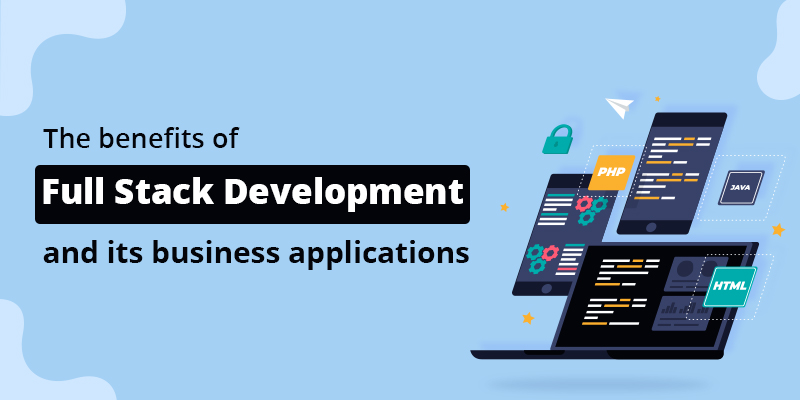
The benefits of Full-stack development and its business applications
“Full-stack development is the art of seamlessly connecting the dots between the front-end, back-end, and everything in between to deliver elegant and efficient solutions.”
This quote highlights the essence of full-stack development – the ability to create end-to-end solutions that are elegant, efficient, and seamless. Full-stack developers have a deep understanding of the entire development process, enabling them to connect the dots between the different layers of a software application. They can develop user interfaces that are intuitive and visually appealing, as well as back-end systems that are robust and scalable. They also have the skills to integrate various technologies and tools to create cohesive solutions that work seamlessly together.
To master the field of full-stack development, we recommend you to watch our Full Stack Web Development Course video.
In essence, full-stack development is about creating solutions that are holistic, efficient, and optimized for performance. It requires a broad range of skills, including front-end development, back-end development, and database management, as well as the ability to communicate effectively and work well in a team. With these skills, full-stack developers can create solutions that meet the needs of businesses and deliver value to end-users.
What is Full Stack development?
The process of creating online applications that incorporate both client-side and server-side programming is known as full stack development. A full stack developer is in charge of creating and maintaining all components of a web application, such as the front-end, back-end, database, and server-side scripting.
A web application’s front-end, or client-side, is what the user sees and interacts with. It comprises the application’s user interface, design, and layout. HTML, CSS, JavaScript, and numerous frameworks such as React, Angular, or Vue are examples of front-end technology.
The back-end, or server-side, of a web application is in charge of data management and business logic. It consists of the server, database, and APIs. Node.js, Python, Ruby, Java, and PHP are examples of back-end technologies, as are databases such as MySQL, MongoDB, or PostgreSQL.
Full stack engineers must be skilled in both front-end and back-end technologies, as well as understand how these components interact to make a functional online application. They must have programming, problem-solving, database administration, and project management abilities.
Who is a Full-Stack developer?
A full-stack developer is a software engineer who can work on both the front-end and back-end of a website. They possess the abilities and expertise required to design, create, and deploy a whole web application, from the user interface to the database and server-side logic.
Front-end technologies such as HTML, CSS, and JavaScript, as well as newer front-end frameworks such as React, Angular, or Vue, should be familiar to a full-stack developer. They should also be familiar with back-end programming languages such as Node.js, Python, Ruby, Java, or PHP, as well as databases such as MySQL, MongoDB, or PostgreSQL.
A full-stack developer should have strong problem-solving abilities, outstanding communication skills, and the ability to work successfully in a team context, in addition to technical talents. They should also have project management expertise and be able to manage their time efficiently in order to achieve project deadlines.
Benefits of Full-stack development
Full-stack development has various advantages:
- Versatility: Full-stack developers have a wide variety of talents and can work on numerous elements of a project, making them extremely flexible. They are knowledgeable in several programming languages, frameworks, and tools and can work on both front-end and back-end technologies.
- Time and cost-effective: Employing a full-stack developer saves time and money compared to hiring individual front-end and back-end engineers. This is due to the fact that a full-stack developer can handle all parts of a project, eliminating the need for extra resources and saving time.
- Improved problem-solving: Because full-stack developers understand the complete development process, they can diagnose and fix problems more rapidly.
- Improved collaboration: Since full-stack developers have a broad understanding of the development process, they can better communicate and collaborate with other members of the development team. This leads to a more cohesive and efficient development process.
- Ability to create end-to-end solutions: Full-stack developers can create end-to-end solutions, from the user interface to the server-side logic, and are able to take complete ownership of a project. This allows them to create cohesive and integrated solutions that work seamlessly together.
Business Applications of Full-Stack development
Here are some detailed business applications of full-stack development:
- Creating web applications: Full-stack development is widely used for building web applications, which can be used by businesses for various purposes such as customer engagement, business operations, and marketing. Web applications developed by full-stack developers are scalable, secure, and optimized for performance.
- Developing mobile applications: Full-stack developers can also create mobile applications using technologies such as React Native, which enables businesses to develop applications that work seamlessly across both iOS and Android platforms. Mobile applications developed by full-stack developers can improve customer engagement and provide businesses with new revenue streams.
- Developing e-commerce websites: Full-stack developers can build e-commerce websites that enable businesses to sell products online, manage inventory, and process payments securely. E-commerce websites developed by full-stack developers are optimized for SEO, responsive design, and provide a seamless user experience.
- Building custom software solutions: Full-stack development is widely used for building custom software solutions tailored to the specific needs of a business. Full-stack developers can develop software that automates business workflows, enables data-driven decision making, and enhances customer experiences.
- Enhancing existing applications: Full-stack developers can improve existing applications by adding new features, improving performance, and enhancing user experiences. This can be particularly beneficial for businesses that have outdated software or require software that meets specific business requirements.
Future of Full-stack development
Full-stack development has a bright future, with various trends developing that will affect the business in the next few years. These are a few major trends:
- Demand for full-stack developers is expected to rise as firms seek to simplify their development processes and cut expenses. This is due to the fact that full-stack engineers may handle various areas of a project simultaneously, eliminating the need for extra personnel.
- Emerging technologies such as artificial intelligence (AI), machine learning (ML), and blockchain are set to play an increasingly prominent role in full-stack development. To be competitive in the business, full-stack developers will need to keep current with these technologies.
- Full-stack engineers will continue to prioritize user experience (UX). This includes creating user interfaces that are intuitive, responsive, and visually appealing, as well as efficient and dependable back-end systems.
- As cloud computing becomes more prevalent among enterprises, full-stack developers will need to be familiar with cloud-based technologies such as Amazon Web Services (AWS), Microsoft Azure, and Google Cloud Platform.
- DevOps is a software development methodology that stresses cooperation and communication between developers and IT operations. To be successful in the market, full-stack engineers must grasp DevOps ideas and techniques.






